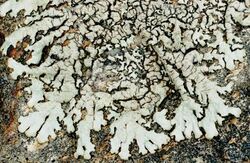Biology:Xanthoparmelia plittii
From HandWiki
Short description: Species of lichen found globally
| Xanthoparmelia plittii | |
|---|---|

| |
| Scientific classification | |
| Domain: | Eukaryota |
| Kingdom: | Fungi |
| Division: | Ascomycota |
| Class: | Lecanoromycetes |
| Order: | Lecanorales |
| Family: | Parmeliaceae |
| Genus: | Xanthoparmelia |
| Species: | X. plittii
|
| Binomial name | |
| Xanthoparmelia plittii (Gyeln.) Hale (1974) [2]
| |
| Synonyms | |
| |
Xanthoparmelia plittii is a lichen which belongs to the Xanthoparmelia genus.
Description
Xanthoparmelia plittii grows to around 4-10 cm in diameter with irregularly lobate lobes which are approximately 0.5-2 mm wide. The upper surface of the lichen is yellow-green with a smooth and shiny surface. While the lower surface being pale or medium brown in color with moderate to densely packed rhizinate anchoring the lichen to the surface.[3][4]
Habitat and range
Xanthoparmelia plittii has been observed mostly in North America,[5][6] but has been found in South America[7] and Europe as well.[8][9]
Chemistry
Xanthoparmelia plittii has been found to contain usnic acid.[10]
See also
References
- ↑ "NatureServe Explorer - Xanthoparmelia plittii". NatureServe. 2022-08-23. https://explorer.natureserve.org/Taxon/ELEMENT_GLOBAL.2.125031/Xanthoparmelia_plittii.
- ↑ "Xanthoparmelia plittii (Gyeln.) Hale" (in en). https://www.gbif.org/species/3407998.
- ↑ Hutten, M.; Arup, U.; Breuss, O.; Esslinger, T. L.; Fryday, A. M.; Knudsen, K.; Lendemer, J. C.; Printzen, C. et al. (2013-09-09). "Lichens and Lichenicolous Fungi of Yosemite National Park, California". North American Fungi 8: 1. doi:10.2509/naf2013.008.011. ISSN 1937-786X. http://openjournals.wsu.edu/index.php/pnwfungi/article/view/1131.
- ↑ "CNALH - Xanthoparmelia plittii". https://lichenportal.org/cnalh/taxa/index.php?taxon=54765&clid=1016.
- ↑ Leavitt, Steven D.; Clair, Larry L. St. (2008). "Lichens of the Boulder Mountain Plateau, Wayne County, Utah, USA" (in en). Evansia 25 (4): 85–89. doi:10.1639/0747-9859-25.4.85. ISSN 0747-9859. http://www.bioone.org/doi/abs/10.1639/0747-9859-25.4.85.
- ↑ Czeczuga, Bazyli; Eversman, Sharon (1993). "Carotenoids in Lichens from Yellowstone National Park and Adjacent Forests in Montana and Wyoming". The Bryologist 96 (1): 102. doi:10.2307/3243325. https://www.jstor.org/stable/3243325.
- ↑ Gerlach, Alice da Cruz Lima; Eliasaro, Sionara (2012). "Liquens parmelioides eciliados (Parmeliaceae, Ascomycota) em costões rochosos dos estados do Paraná e Santa Catarina, Brasil" (in pt). Acta Botanica Brasilica 26 (3): 570–584. doi:10.1590/S0102-33062012000300007. ISSN 0102-3306.
- ↑ Rizzi, G.; Giordani, P. (2013). "The ecology of the lichen genus Xanthoparmelia in Italy: An investigation throughout spatial scales" (in en). Plant Biosystems 147 (1): 33–39. doi:10.1080/11263504.2012.717546. ISSN 1126-3504. https://www.tandfonline.com/doi/full/10.1080/11263504.2012.717546.
- ↑ Ochyra, Ryszard (2014-01-01). "New Books: Hertel H. (2012): Gattungseponyme bei Flechten und lichenicolen Pilzen.". Acta Musei Silesiae, Scientiae Naturales 63 (1). doi:10.2478/cszma-2014-0006. ISSN 2336-3207.
- ↑ Kanigowski, Paweł; Flakus, Adam; Oset, Magdalena; Kowalewska, Agnieszka; Rykaczewki, Max; Kukwa, Martin (2016-06-01). "The Lichen Family Parmeliaceae in Poland. Xanthoparmelia Species Containing Usnic Acid". Herzogia 29 (1): 108. doi:10.13158/heia.29.1.2016.108. ISSN 0018-0971. https://bioone.org/journals/herzogia/volume-29/issue-1/heia.29.1.2016.108/The-Lichen-Family-Parmeliaceae-in-Poland-Xanthoparmelia-Species-Containing-Usnic/10.13158/heia.29.1.2016.108.full.
Wikidata ☰ Q10721551 entry
 |


